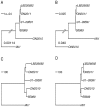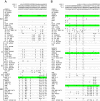Phylogenetic incongruence in E. coli O104: understanding the evolutionary relationships of emerging pathogens in the face of homologous recombination
- PMID: 22493677
- PMCID: PMC3320906
- DOI: 10.1371/journal.pone.0033971
Phylogenetic incongruence in E. coli O104: understanding the evolutionary relationships of emerging pathogens in the face of homologous recombination
Abstract
Escherichia coli O104:H4 was identified as an emerging pathogen during the spring and summer of 2011 and was responsible for a widespread outbreak that resulted in the deaths of 50 people and sickened over 4075. Traditional phenotypic and genotypic assays, such as serotyping, pulsed field gel electrophoresis (PFGE), and multilocus sequence typing (MLST), permit identification and classification of bacterial pathogens, but cannot accurately resolve relationships among genotypically similar but pathotypically different isolates. To understand the evolutionary origins of E. coli O104:H4, we sequenced two strains isolated in Ontario, Canada. One was epidemiologically linked to the 2011 outbreak, and the second, unrelated isolate, was obtained in 2010. MLST analysis indicated that both isolates are of the same sequence type (ST678), but whole-genome sequencing revealed differences in chromosomal and plasmid content. Through comprehensive phylogenetic analysis of five O104:H4 ST678 genomes, we identified 167 genes in three gene clusters that have undergone homologous recombination with distantly related E. coli strains. These recombination events have resulted in unexpectedly high sequence diversity within the same sequence type. Failure to recognize or adjust for homologous recombination can result in phylogenetic incongruence. Understanding the extent of homologous recombination among different strains of the same sequence type may explain the pathotypic differences between the ON2010 and ON2011 strains and help shed new light on the emergence of this new pathogen.
Conflict of interest statement
Figures











Similar articles
-
Comparative genomics of recent Shiga toxin-producing Escherichia coli O104:H4: short-term evolution of an emerging pathogen.mBio. 2013 Jan 22;4(1):e00452-12. doi: 10.1128/mBio.00452-12. mBio. 2013. PMID: 23341549 Free PMC article.
-
Alignment-free design of highly discriminatory diagnostic primer sets for Escherichia coli O104:H4 outbreak strains.PLoS One. 2012;7(4):e34498. doi: 10.1371/journal.pone.0034498. Epub 2012 Apr 5. PLoS One. 2012. PMID: 22496820 Free PMC article.
-
An investigation of the diversity of strains of enteroaggregative Escherichia coli isolated from cases associated with a large multi-pathogen foodborne outbreak in the UK.PLoS One. 2014 May 20;9(5):e98103. doi: 10.1371/journal.pone.0098103. eCollection 2014. PLoS One. 2014. PMID: 24844597 Free PMC article.
-
Characteristics of the Shiga-toxin-producing enteroaggregative Escherichia coli O104:H4 German outbreak strain and of STEC strains isolated in Spain.Int Microbiol. 2011 Sep;14(3):121-41. doi: 10.2436/20.1501.01.142. Int Microbiol. 2011. PMID: 22101411 Review.
-
Escherichia coli O104:H4 Pathogenesis: an Enteroaggregative E. coli/Shiga Toxin-Producing E. coli Explosive Cocktail of High Virulence.Microbiol Spectr. 2014 Dec;2(6). doi: 10.1128/microbiolspec.EHEC-0008-2013. Microbiol Spectr. 2014. PMID: 26104460 Review.
Cited by
-
Escherichia coli O104 in Feedlot Cattle Feces: Prevalence, Isolation and Characterization.PLoS One. 2016 Mar 24;11(3):e0152101. doi: 10.1371/journal.pone.0152101. eCollection 2016. PLoS One. 2016. PMID: 27010226 Free PMC article.
-
Circulation of Shiga Toxin-Producing Escherichia coli Phylogenetic Group B1 Strains Between Calve Stable Manure and Pasture Land With Grazing Heifers.Front Microbiol. 2020 Jun 30;11:1355. doi: 10.3389/fmicb.2020.01355. eCollection 2020. Front Microbiol. 2020. PMID: 32714297 Free PMC article.
-
When whole-genome alignments just won't work: kSNP v2 software for alignment-free SNP discovery and phylogenetics of hundreds of microbial genomes.PLoS One. 2013 Dec 9;8(12):e81760. doi: 10.1371/journal.pone.0081760. eCollection 2013. PLoS One. 2013. PMID: 24349125 Free PMC article.
-
Bloody coli: a gene cocktail in Escherichia coli O104:H4.mBio. 2013 Feb 19;4(1):e00066-13. doi: 10.1128/mBio.00066-13. mBio. 2013. PMID: 23422408 Free PMC article.
-
Extensive genomic variation within clonal bacterial groups resulted from homologous recombination.Mob Genet Elements. 2013 Jan 1;3(1):e23463. doi: 10.4161/mge.23463. Mob Genet Elements. 2013. PMID: 23734294 Free PMC article.
References
-
- Ochman H, Lawrence JG, Groisman EA. Lateral gene transfer and the nature of bacterial innovation. Nature. 2000;405:299–304. - PubMed
-
- Dobrindt U, Hacker J. Whole genome plasticity in pathogenic bacteria. Curr Opin Microbiol. 2001;4:550–557. - PubMed
-
- Hacker J, Blum-Oehler G, Muhldorfer I, Tschape H. Pathogenicity islands of virulent bacteria: structure, function and impact on microbial evolution. Mol Microbiol. 1997;23:1089–1097. - PubMed
-
- McGraw EA, Li J, Selander RK, Whittam TS. Molecular evolution and mosaic structure of alpha, beta, and gamma intimins of pathogenic Escherichia coli. Mol Biol Evol. 1999;16:12–22. - PubMed
-
- Posada D, Crandall KA, Holmes EC. Recombination in evolutionary genomics. Annu Rev Genet. 2002;36:75–97. - PubMed
Publication types
MeSH terms
LinkOut - more resources
Full Text Sources
Medical
Molecular Biology Databases

